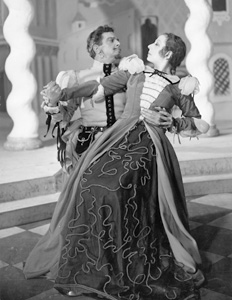Taming of the Shrew, The, is the name of a comedy by the great English dramatist William Shakespeare. It is one of Shakespeare’s most delightful comedies and belongs to the first period of his artistic development. It was written and first acted probably in 1592 or 1593. The Taming of the Shrew is based partly on Supposes, a comedy by the English author George Gascoigne, which was itself adapted from a story by the Italian poet Ludovico Ariosto. The Taming of a Shrew, a comedy by an unknown English playwright published in 1594, was once believed to be a source for Shakespeare’s play. But many scholars now think that this 1594 publication was an inaccurate version of Shakespeare’s own play. Shakespeare’s The Taming of the Shrew was not officially published until 1623, but even then the text was corrupt.
In its published form, The Taming of the Shrew is a play-within-a-play. It begins with an induction (introductory scene). This takes place outside a Warwickshire alehouse, where Christopher Sly, a drunken tinker, falls asleep after an argument with the hostess of the inn. A group of huntsmen, led by a local lord, find the tinker and decide to play a trick on him by taking him back to the lord’s home and making him think he too is a lord who has been out of his mind. He is set down to watch the play that follows, performed by a group of strolling players.
The play Sly watches is set in Padua, Italy. Baptista Minola has two daughters. The younger one, the beautiful Bianca, has many suitors, but she cannot marry until her sister Katherine, Minola’s elder daughter, has found a husband. Petruchio, a young Italian gentleman from Verona, agrees to woo the beautiful but shrewish (bad-tempered) Katherine, whose biting tongue has discouraged other suitors. His motives are to win Katherine’s dowry and to help his friend Hortensio win Bianca. Petruchio marries Katherine, although he turns up at the wedding late and improperly dressed. Both before and after the wedding, he systematically humiliates Katherine to cure her of her temper. After many comical clashes between the two, Petruchio’s strategy succeeds, and Katherine becomes an obedient wife. Bianca, however, is courted and won by Lucentio, a young man from Pisa. Hortensio has to settle for a rich widow instead. At the feast that ends the play, Petruchio wagers with the other two bridegrooms as to whose wife is the most obedient. A docile, submissive Katherine wins the bet for him. At this point, Petruchio reveals himself to be a true gentleman genuinely in love with Katherine.

A broad and vigorous comedy, The Taming of the Shrew provides two outstanding roles in the characters of the battling lovers. The parts of Petruchio and Katherine have been a showcase for generations of gifted actors and actresses. The American composer Cole Porter based his hit sophisticated musical Kiss Me, Kate (1948) on this play.
